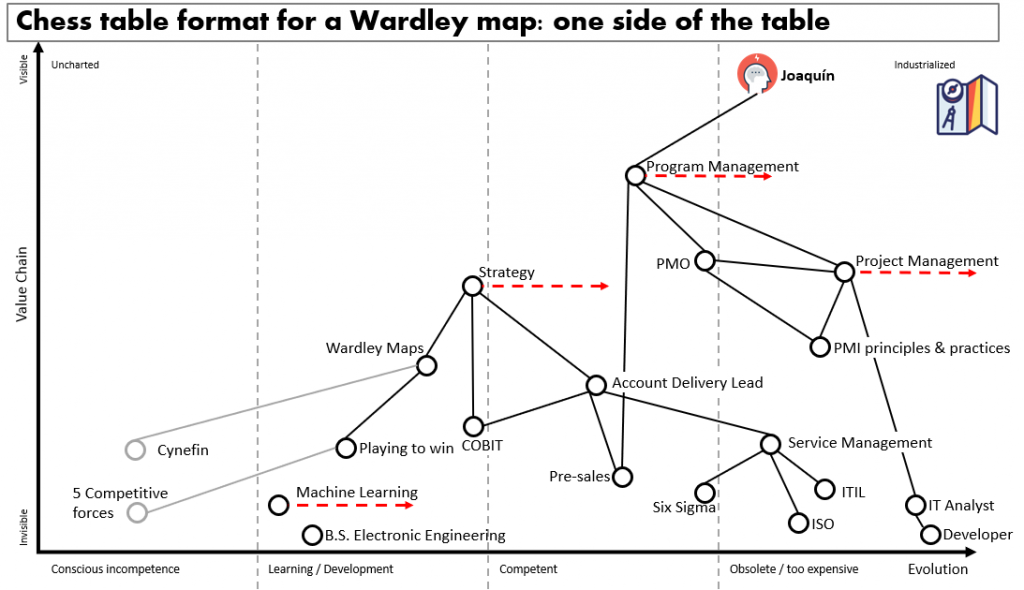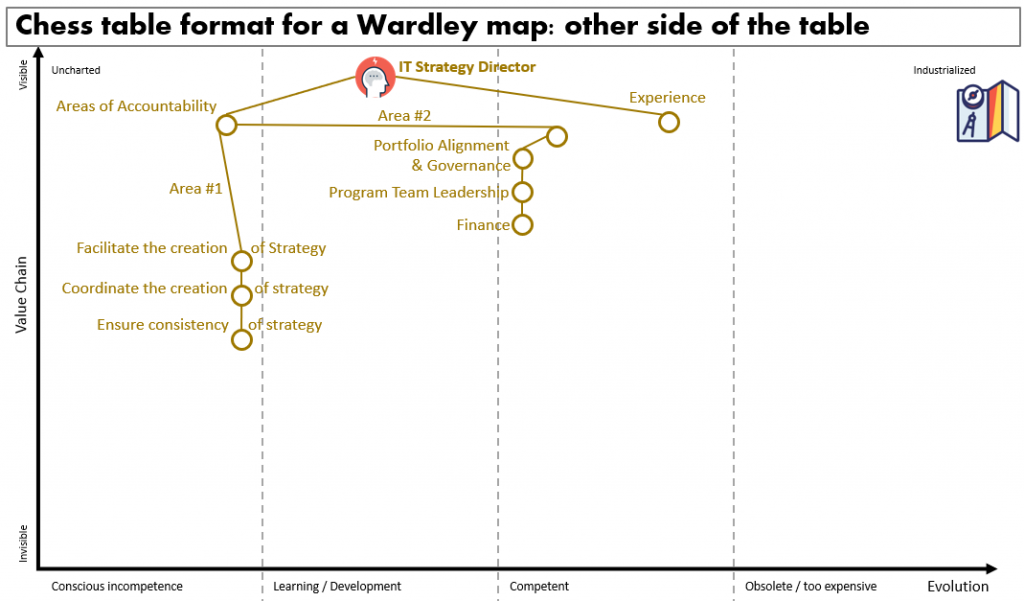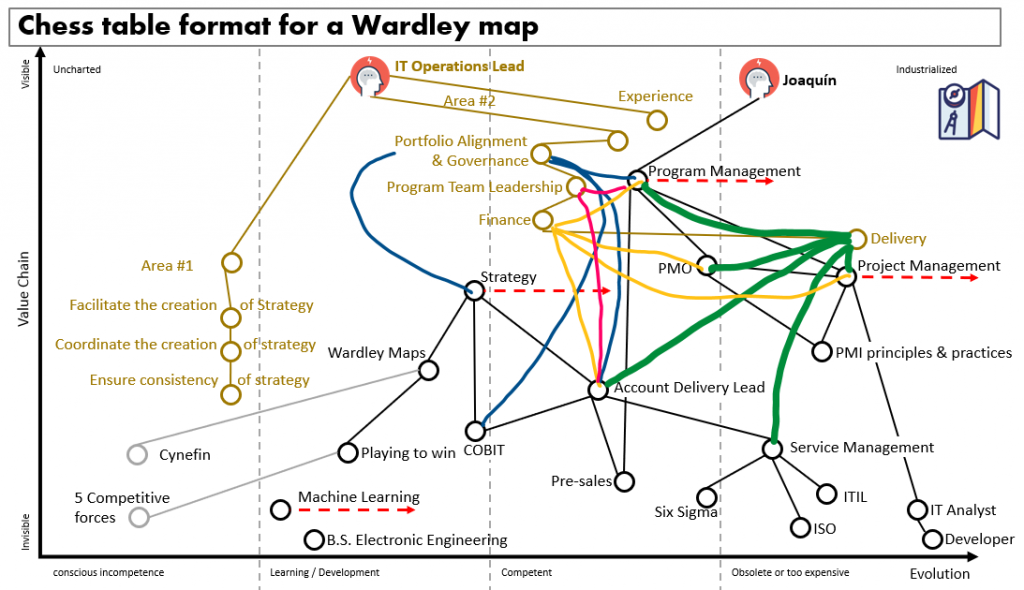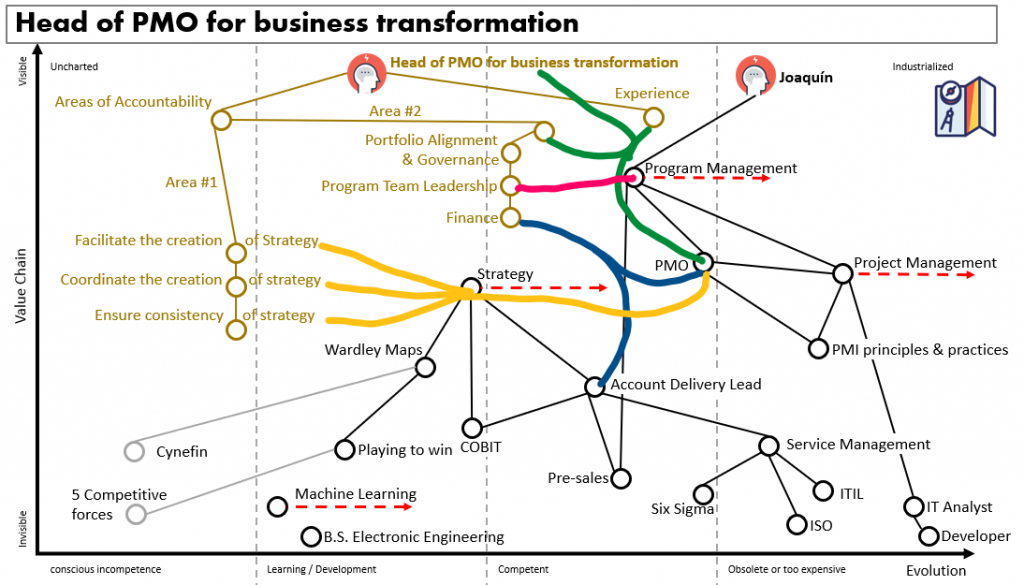I have been thinking about the evolution of my personal development and how to progress on other areas of competency. I used to do this using a notebook listing the next future jobs that will show up, their main features, how appealing are to me and how I really fit on them. After that, I prepare myself to try to be competent on the target one.
This time, I already have clear the target, and the problem I have is how to find the environment that recognizes, requires and is willing to pay me to work on activities where strategy is one of the main elements.
So I decided to do a map, a standard map, and it did not fit well as the anchor should not be only the target organization requiring my skills and experience, but I needed two anchors: the second one is me.
I did some changes too on the evolution axis, in the color conventions and some other details; so I will try to explain how I drawn the concepts.
I discussed about this map with Krzysztof Daniel, and you can watch it here.
Chess table has two colors: black and brown
I have colored the map with two colors to identify and play with the situation that we have two clear anchors on the map, subjected to evolution and requiring value to close a trade.
Brown and black was the colors I picked so I can use the same recognized other colors for the other representations.
The evolution axis
I have changed the classic evolution axis for components (genesis, development, product, utility) to a different one:
- Conscious competence: This stage contains components about capabilities (in my case) and needs in the case of an organization. I have thought about to add “unconscious competence” but I finally discarded the idea because I do not find relevant value.
- Learning / Development: This is an early stage where one side of the table is learning and gaining capabilities in the organization to be able to extend them into the rest of the organization, and the other side of the table is learning capabilities to gain competency on a given capability (i.e. a company doing machine learning pilot, before to use it on production).
- Competent: this stage of evolution the organization or the person is able to operate using the capabilities shown on the area.
- Obsolete or too expensive: this mainly belongs to the individual, when a professional progress, there are capabilities that if you are not focused on evolving them, they are obsolete. In IT world this is more clear, but it happens everywhere, why? because when a professional is in the market the trend is to increase its income when progressing and this makes that there is a point where the market is not willing to pay some prices for some capabilities. And if you jump from one type of role to other one, soon you will be obsolete for the previous role. In the case of the organization, this will be a relevant capability that should be basis for other things (here I have doubts).
Well, this proposed stages does not follow exactly the Peter’s principle, but the idea is similar in a more practical way.
Distance between capabilities and needs
Here I have thought about many different ways to represent how close or far are the needs and the capabilities. I have not a clear way to represent it, and the room for improvement is infinite. In case you have an idea, it’s more than welcome.
The lines on the pictures are a mess, but when you are drawing, discussing and removing them on a meeting with other people, the dynamic is good.
Placing the pieces on the board
I started the map with one anchor: me. and I reviewed main roles and areas of competence I have been working. The use of standards as ITIL, PMI… help to others to recognize what I was doing, so I keep it in that simplified way. The result right now is this one:

I will do a review of the main ideas I want to represent, but not a detail description of my evolution (it’s irrelevant now).
- Program management and project management are the main areas of competency I am working on right now, so it means that is where I am mainly progressing.
- Account delivery Lead was a role I have done for years and that I love to do, it gave me a lot of experience and exposure to operations and senior clients that in reality to me is more relevant that I draw there.
- Project Management is not necessary that could be in “obsolete / too expensive”, because the evolution of a project manager can be very long, be diverse and enriching as you want. The point is that right now is not my main priority, but there are many skills and knowledge that I use everyday about it. So, The point is that I’m not convinced that this position in the map is the right one.
- There are two points where I’m trying to learn and increase my competences:
- Strategy: my main learning come from reading, practicing about Wardley maps, watching videos and listening podcasts. I practice during my programs and I keep some maps related to companies up to date to check the evolution I figured out and see how they are evolving and change. This is a skill, a capacity that can help me to work on a role where strategy is relevant skill.
- Machine Learning: I am learning the main concepts, some models and I am coding in python some neural networks and models to understand the stages of a project. I do not pretend to be developer again, but in case a program or a major project related to machine learning shows up, then the other side of the table can identify me as the right person to do it and I can jump in with confidence.
- Components under strategy:
- Playing to win: I am reading a lot about all the concepts, practices and recommendations done by Roger L. Martin around the concept of “playing to win”. It looks so many things that I know by hard from Wardley mapping but from different perspective. There are so many concepts that are similar in both proposed frameworks (for instance “aspiration to win” and “purpose”) but they are reviewed differently. I have linked it to Wardley maps because in so many aspects Wardley maps is an evolution of “playing to win”.
- Cynefin: I have read the basis, but it’s in grey because I’m “conscious incompetent” on it. I have linked to Wardley maps because the maps made me aware of Cynefin.
- Five competitive forces: written by Michael Porter, I have the same situation than with Cynefin, I’m a “conscious incompetent”, and in Martin’s books you will find the name of Michael Porter, I find that Martin took some learnings from these concepts, so by that reason I linked in that way.
Now let’s go to the other side of the table: the target occupation for me.

Here the first thing you can challenge is the election of the anchor, “IT Strategy Director“. If you look into a job board for vacancies this role will not be found. As I have written on this post, the role is an utopia, I will not find a job with that title, I will probably find a role where the strategy as skill and competence is relevant and the organization requesting it values the skills and experiences on strategy. Maybe it will be an operations role, a portfolio manager, a program manager… who knows?
In any case, to name it “IT strategy Director” is important to do not lose the aspiration that I’m willing to take.
- Experience, is something expected on this utopic role, so I set it on “competent stage.
- Areas of accountability: here I have so many doubts, and I will explain why I did it in this way.
- Area #2: yes I start with the #2. I identify the role of portfolio manager on the IT business as the role with the need of these three main competencies. This role is recognized in so many organizations and they are perfectly available to need a person to cover that competency as they recognize and have the need.
- Area #1: there work around the strategy as competence for a given organization is for the majority of the organization an “unconscious incompetence”, so they do not understand they need it. But there are some few organizations that recognizes this need, and these are the ones important to me. On the description of “IT Strategy Director” you can find my understanding about facilitate, coordinate and ensure the creation of strategy. To be is a role with so many similarities to the Head of PMO.
These areas of accountability can be move to the right or two the left depending the specific organization that I use to find connections, so the initial positions I have given to the components are completely wrong and they have to be adapted to a given organization (fine tune).
The complete chess table
This map contains the 2 sides of the table, and it’s incomplete:

Why is this incomplete? well, this is the basis to see the points in common between Joaquín and a given organization that is willing to see Joaquín as a valuable asset. From my side of the table what I want to understand is how far or close I am from fitting needs and capabilities. And other important question is to sit my self on the other side of the table so I force myself to check if I’m relevant for them or not. If I’m not a recognized professional for the other side of the table I have first to recognized the gap and then see what to do (skip, work on it… whatever).
So let’s measure distance and how it fits for a couple of examples
The examples will be very simple and you will say: you do not need a map to see this. And it’s true I do not need a map, but I want to explore the use of this representation to check if there is value on using it when the scenario is not simple.
Example 1: organization requiring a IT Operations Lead with ability to transform
On this scenario I will do the following links and lines:
- Area #1: it’s irrelevant.
- Area #2: it’s relevant as it will support the need to govern, lead and transform the operations. I have added the need of delivery as key for the role. I have moved the components in a way that reflects the needs of the position.
I know, so many lines and colors, you have to pay some attention to it. Each color links each need to where I see my capabilities and experience is relevant. Here strategy is a capability that could be seen as irrelevant or as a differentiator, but first you have to fit on the main capabilities: able to deliver, able to transform.

Example #2: Head of PMO for business transformation
On this scenario I’m assuming the organization is willing to perform a strong transformation and will be using existing PMO processes and framework to support the forecasted transformation but in addition to it, they recognize that change management and ability to coordinate fast in the changes is key, awareness of changes of scenarios and ability of the organization to adapt while delivering and transform is a hot topic for them.
This is the way I drawn the map and the potential links:

Again, links to the main components in common from my point of view. Here I guess the organization recognizes the need of strategy as a skill that is part of the PMO lead, and my opportunity could be if they identify my experience on the topic as differentiator with respect the other candidates.
Other thoughts
This type of map invites to paint and review the table of doctrines to check the fit of the individual in the organization while asking: does this individual fits in the culture of my company? or vice versa.
I hope this type of adapted format makes sense to you. Is it the right one? probably not, but it has let me think about so many things in a different way as the Wardley maps has challenge me to draw it better and that forced me to go deeper with the questions.
Any feedback is more than welcome
Interesting, but I think on your black map- evolution of personal skills would lead to an upward arrow, not just an evolution one – these skills should become more evident to you and to others? These in turn would drag in some things that are currently off-map (like areas of accountability). As a (rational) professional you should look to go as high top-left as possible – you want to be unique and visible if you want to be best paid, or instead you might value purpose, and choose a node to circle around, or simply enjoy being connected to many other things (depending on what you’re motivated by).
My gut tells me you’re mapping slightly the wrong thing in the wrong way. You could map the role of PMO within your chosen sector, and then see where you intersect. I would be looking at the forces acting on the PMO role – arguably you’ve got Experience and Strategy round the wrong way – experience is specific, strategy formulation is more generic. Technology is impacting strategy more than experience etc etc
Hello Iván,
thanks for your comment. So many thought, so here I go:
* Related to the upward components instead of evolution, this is the right thing if I consider the regular X-Axis, but one of the purposes is to play with this X-Axis and see how it works because you are trapped from left and right side of the map.
* I agree, in terms of differentiation the more left a capability you have, the most different you will be, and probably less offer will be in market. For instance a python developer with expertise in AR libraries is very unique and will bright in a market full of offers like that.
* Related to “areas of accountability”, you are right, a professional is more than main roles and there are so much behind it. I did not mentioned anything about industries, technologies, and other perspectives than an employer is considering.
* I agree with the fact that the map is doubly wrong. My point is, I have used this map to try to represent some concepts, and challenge the fact that all roles have already a name. The example of IT Strategy Director tries to look into something that is not common, or at least not common to me. And in this way try to play how it works. I agree that to do a clear role identification in front of my skills/experience/etc. is makes more sense. In reality I would not need a map for that.
best regards,
Joaquín
Thanks for sharing this step. Makes an interesting thought if the two sides would line up in overlapping ways. That could look for capability change or needs.
I wonder if you played it out over a number of months the IT director’s key areas and skills would shepard the other side chain in the direction that was desired, like an old Napoleonic map of forces driving the other force back, but in a positive direction.
Or conversely if the point from left to right the points on the map moved were based on some sort of performance or survey data, could it be seen if the Accountability or OKRs were set wrong and were not driving the outcome.
Hello Tristan,
thanks for your comment.
If both sides are overlapped, I would say that the IT Director need can be carried on by the person offering such knowledge/experience.
I have not represented the evolution of the role request, but I have thought about it too much. The point is that in the last 5 years the nomenclature have changed a lot, but the root of knowledge/experience has not changed too much.
For instance, I have discovered that what I called “Team Lead” right now is named “coaching”, a role that 12 years ago it was “Applications delivery Lead” is very similar to the today’s “portfolio manager” or “engagement manager”. But the things to be done, the attitude doing that role are very similar.
In the case of the role of “IT Strategy Director” I think that it can have different shapes and that organizations have people acting as “IT Strategy Directors” but some of them do not know it or recognize it formally as a role (and probably it’s because it’s not necessary).